Nigel J. Ross
Travelogue

* clicking on asterisked pictures takes you to a large-size photo
Nearly a month in Sumatra, and what a lot of things we managed to pack into that month: jungle, lakes, mountains, volcanoes, seaside, tropical fish, fascinating towns and villages, unusual local cultures and more besides. I never thought it was going to be such an interesting and varied holiday.
The journey out on July 19th (with Lauda Air via Vienna to Kuala Lumpur) went very smoothly, marred only by a freezing-cold five hour wait for our connection in Kuala Lumpur airport. It had turned cold outside, and it was pouring down very heavily in KL – it is their wet season there – that the air-conditioning inside the airport was overdoing the cool. We were very glad to leave for the third and final flight of our outward journey to Medan (aboard Malaysian Airlines). After super-modern KL airport, Medan airport was little more than a cattle barn. The airport is pretty close to the city, so we took a rickshaw to the hotel. The poor rickshaw driver had a hard time of pedalling into the city with the two of us and our luggage. The highly recommended hotel we'd planned staying at proved to have become very dirty and neglected, so we opted for another one nearby – a little more expensive, but clean and bright.
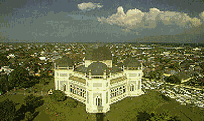 Medan, the Black Mosque
Medan, the Black Mosque
We spent two full days in Medan, more than we needed to. The first day we got unpacked and strolled round a bit near the hotel, trying to get acclimatised and over our jet lag. The city is not very well cared for, rather dirty and not particularly attractive. The next day, Sunday, we did the sights. The Black Mosque (its domes are black) was quite interesting as was the Sultan's palace, Maimoon Palace, though we only got a chance to see it for a very short while as it was soon closed to the public for a private function. We found it hard to fill in the rest of the day, most shops being closed, there being little else to do, but we had a walk around other areas, confirming our suspicions that the place is rather unattractive, despite being the largest city in Sumatra.
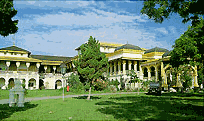 Medan, Maimoon Palace
Medan, Maimoon Palace
The next day we took a taxi to the bus station and got a bus to Bukit Lawang, a five hour trip from Medan. Bukit Lawang is the last place at the end of a road, and right on the edge of the northern jungle, in a national park. We stayed there a few nights in a nice, quiet hotel on the river banks, enjoying the peace after noisy and dirty Medan. While staying there, we visited the orang-utan rehabilitation centre where orangs that have been orphaned, injured or captured (sometimes as babies and sold as pets which become unwanted when they grow up) are gradually taught how to re-adapt to the wild. We saw the orangs being fed, and were particularly delighted to see a mother and baby at the feeding place.
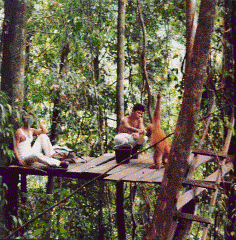 Orang-utan rehabilitation centre*
Orang-utan rehabilitation centre*
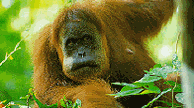
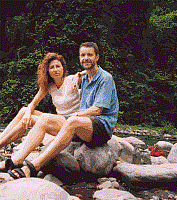
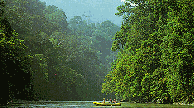 Bukit Lawang
Bukit Lawang
Another day while staying in the jungle we went on a day's hike with a park ranger and four other tourists. The ranger was very knowledgeable, showing us all different kinds of plants and insect life, and we also spotted macaque monkeys and gibbons. The vociferous gibbons swinging from high branches of trees were fascinating, their song-like calls echoing through the jungle. We ate a lunch provided by the ranger off banana leaves, and came back part of the way by wading along the river, where we also saw a chameleon. Even the latter part of the hike back through banana plantations and rubber plantations was fascinating.
We were a bit reluctant to leave Bukit Lawang, enjoying its peace and quiet, but after four days there we decided to move on to Berestagi, a long drive from Bukit Lawang, passing through the outskirts of Medan (a stretch of the journey which took quite some time because of the heavy traffic there). Journeying was never quick in Sumatra, the roads being narrow and badly kept, often with large potholes, making for a rather bumpy ride at times. We found a nice hotel in Berestagi, based around a Dutch villa on the outskirts of the town with beautifully tended gardens. We were rather surprised at the temperatures in Berestagi, lying at 1,300 metres above sea level meant for coolish nights. Berestagi has excellent markets and we enjoyed exploring these. One day we spent climbing a nearby volcano – Mount Sibayak (2,100 metres). It was not a particularly difficult climb, taking us about three hours to get to the top. There is a deep crater at the top, and all around geysers spewing out foul-smelling sulphuric gases and yellowish dust, dotting the grey rocks with splashes of bright lemony-yellow. We came down by another route, described in the guidebook as "steps", but most the steps had fallen into disrepair and were also very slippery after a short shower. It was a difficult descent, but interesting as we passed from bare rock to dense vegetation and eventually bamboo forests. On the way down we stopped off at some hot (sulphuric) springs where we enjoyed a wonderfully hot soak. The water was in fact too hot to stay in for long, like an over-hot bath. We soon got used to the disgusting smell, though the clothes we put on afterwards took on the smell and still seem to have it a bit.
Another day we took local buses to visit a nearby village called Lingga. We had difficulty with the local buses, at one stage getting on one that went in completely the wrong direction. Eventually, four buses later and thanks to some very helpful locals, we finally got to Lingga. In the village there are some wonderful examples of Karo Batak houses. The Bataks were one of the original peoples of Sumatra, having a fascinating culture and divided into various sub-groups, including the Karo Bataks. They lived in communities, up to twelve families living in very large longhouses on stilts and with soaring roofs. Some of the houses in Lingga were particularly fine, with decorated gables and thatched roofs. A local girl who is studying English at Medan university invited us to her home for tea and conversation, and then she showed us around, even taking us into the chief's house.
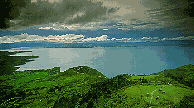
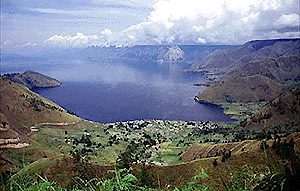 Lake Toba
Lake Toba
The next day we left Berestagi and went by "tourist bus" in pouring rain to Lake Toba. En route we stopped at a long waterfall and another collection of interesting Karo Batak houses. We arrived in Parapat on the shores of Lake Toba in the late afternoon, then took a ferry across to Samosir, the island in the lake, where we stayed for six days. Lake Toba is 900 metres above sea level and is very large, indeed it is the largest lake in SE Asia and is 87 km long. Its microclimate give it ideal temperatures all year round. Samosir, the island within the crater lake is as large as Singapore, but only has a small population. We stayed on the Tuk Tuk peninsula just over the water from the main town on the mainland, Parapat. Tuk Tuk has a number of hotels, but the one we wanted to stay at was full, so for the first night we stayed in a real cheap place nearby (it cost us the vast amount of 1.20 Euros for the two of us). When we moved next day to Tabo Cottages guesthouse, we were very comfortable (and of course it was MUCH more expensive at 3.60 Euros a day for the nice room with bathroom).
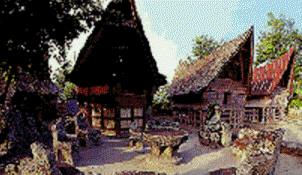 Stone furniture, Ambarita, Lake Toba
Stone furniture, Ambarita, Lake Toba
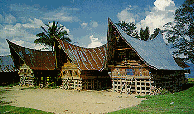 Toba Batak houses, Samosir, Lake Toba
Toba Batak houses, Samosir, Lake Toba
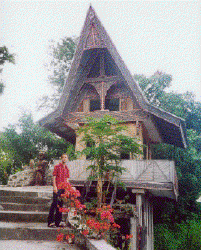 Toba Batak house, Ambarita, Lake Toba*
Toba Batak house, Ambarita, Lake Toba*
We spent a lot of time relaxing on the lake shores, walking around the peninsula, taking things easy. One afternoon we walked a couple of kilometres along the coast to the small town of Ambarita with its fascinating Toba Batak houses and old stone furniture (used by juries to try criminals who, after being found guilty, were tortured and then eaten by one and all – yes the Bataks were cannibals until about 100 years ago, and stories abound about what still happens to undisciplined tourists). Another day we walked to Tomok where we saw more stone carvings, this time of small people, and yet another day we took local buses (one was just a heap of rust) to the tip of the lake to see a Toba Batak museum. One morning, we ferried across to Parapat to book onward travel, to change money and to get flight information (I had realised that it would be best for me to conclude the holiday by flying back from Padang to KL, so I found out details of times and flights).
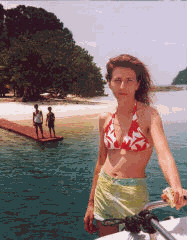
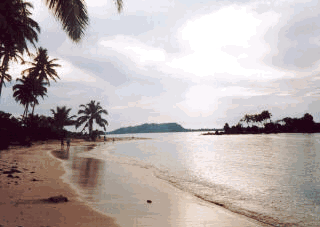 Sibolga (islands)
Sibolga (islands)
From Lake Toba, we drove down narrow, windy, potholed roads to the town of Sibolga, on the coast. From there we took a small ferry across to the island of Poncan in the Sibolga Bay where we'd booked into the Sibolga Marine Resort. The resort, on the sandy, palm-fringed island is quite exclusive, and it was especially exclusive for us, as we were the only guests for most of the time we stayed there. Having over 50 chalets, and large numbers of staff we felt rather pampered, and also rather observed.
We walked around the island, collecting shells and coral, moving from bay to bay, we did some swimming, and went into Sibolga to book onward travel one morning. However, the highlight was a day spent on board a boat that we chartered the last day with four other guests to visit the outer islands in the bay. These outer islands, more or less uninhabited, are true picture-postcard places. We dropped anchor at three of them, though only actually went ashore on one. We spent a good bit of time diving off the boat, swimming in the warm waters, snorkelling on and around the coral reefs, watching the tropical fish which were a delight, a myriad of shapes, sizes and colours.
We had problems from Sibolga as the transport we had booked through an agency didn't materialise. The agent, who two days earlier had assured us our bookings were definite, proved to be a real nasty piece of work. At first he told us we would have to wait for other passengers, then he told us the minibus would only leave if it had four passengers, and so we would have to pay for two other seats. In the end we went to the local bus station and took local buses. This was an option we wanted to avoid as we had to cover about 500 kilometres, but we refused to be "done" by such an unscrupulous agent. We had to change twice on the local buses, and none of them could be described as comfortable. In the first one, three people were squashed onto every seat designed for two, and the vehicle was so old I don't think it had any suspension left. The second one was old and dirty, but the motor sounded good. It trundled along at little more than walking pace through countless villages, picking up and dropping off people and their possessions along the route. At one stage, the corridor of the bus was full of provisions going to market the next day, and most people's luggage (including ours) was on the roof, soaking up a tremendous downpour. We had to wait three hours in a tiny village late in the night for our last connection, and so we crossed the equator totally unawares at about 2:30 in the morning. At 4 o'clock we got to Bukittinggi and managed to wake up a hotel porter to get a room.
The hotel we were in was reasonably adequate, but next door was the mosque, and we'd been woken up by the call to prayer at 5 o'clock … and the call went on very loudly for about half an hour. We didn't want any repeat performances of that. We went for a morning stroll round Bukittinggi, looking into a number of other hotels, and eventually we decided to move to another one just up the road which had a much larger room, was very clean, and faced the opposite way to the mosque. We were too exhausted to do much the first day or two. We spent nearly a week in Bukittinggi and really liked the place, being particularly fascinated by the local Mingangkebau culture. Bukittinggi has an enormous market area, and despite spending the whole of Saturday looking around, we only saw a small part of it. In the market, we tried lots of different nibbles, lots of wonderful fruit, and feasted our eyes on all the things we could never hope to carry home.
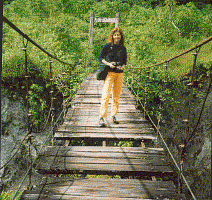 Bukittinggi canyon
Bukittinggi canyon
One afternoon we walked through a canyon across a rickety suspension bridge with a few planks missing to a nearby village that specialises in silversmiths and filigree work. Carla bought a bracelet, but when we got back to the hotel and she opened the packet to have another look, we realised it was not the one she'd chosen but another (cheaper) one. So the next morning we trekked back and changed it, the shopkeeper being very apologetic, though we still feel he tried to pull a fast one on us.
Another day we booked up for an organised tour (it would have been very difficult to do it ourselves on public transport) and went to see a coffee plantation, a water-powered coffee mill, the royal palace of local Mingangkebau culture, Lake Singkarak and local crafts of cloth-making and woodworking. The highlight was the royal palace, a long wooden building, built like the Bataks' houses without the use of nails, and with soaring gables rising to delicate points and with highly-decorated gable-ends and walls. The Mingangkebau culture is fascinating in that it is (still) one of the world's few matriarchal cultures, the women only own property and control the family life.
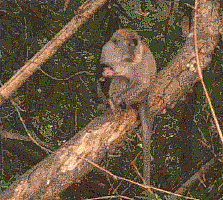
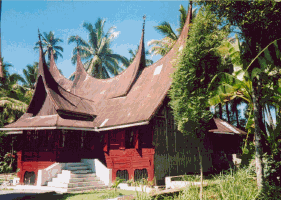
We enjoyed our stay in Bukittinggi, the town itself has another (smaller) Mingangkebau palace, lots of Minangkebau buildings and roofs throughout the town, a fine clock tower, zoo and fort. In the local Panorama Park, overlooking the canyon we'd walked through, there were monkeys everywhere. The food was particularly good in Bukittinggi, though we ate well everywhere. The best Indonesian food comes from the Minang area, more especially from Padang (just two hours away from Bukittinggi), and is hot and spicy, but very tasty. In a typical Padang restaurant, they bring you a plate of rice each and put on your table a small dish of everything on the menu. You then decide what you want to eat, leave the rest (as long as the dish is untouched you don't pay for it) and have a good meal. At times we weren't quite sure quite what vegetable or fish we were eating, but the taste was also good. We also loved the local breakfast / lunch speciality, a kind of fruit-salad cum porridge. On top of a mix of bananas, papaya, pineapple, avocado, honey-flavoured sawo fruit and water apple, they put some steamed oats, some water-buffalo yoghurt, some honey and then some freshly ground coconut – yummie! We loved all the fruits and fruit juices we had there, consuming vast quantities of rambutan, sawo, salaks (a pear-shaped fruit with papery snakeskin-like peel and hard pinkish flesh tasting like a cross between a pear and a walnut), papayas, tiny bananas and so on.
I went into a travel agency in Bukittinggi to book my flight from Padang to KL, only to be told that the plane was broken and there were no flights. So left with no choice, we changed programme and decided to miss out on Padang. I booked to go overland from Bukittinggi to KL, and Carla booked to go to the outlying island of Siberut on a 6-day tour. The island is still almost uncontaminated by the outside world, she would be trekking in the jungle, staying with the locals in primitive longhouses (no electricity, no running water, the toilets are in the local river), and really getting close to one of the few tribes left in Indonesia who have had hardly any contact with outsiders.
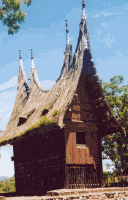
We both left on Monday, I travelled overnight across the island to Dumai from where I got a ferry to Malaysia, to the port of Malacca to be precise. The overnight bus was very bouncy and I didn't get much sleep, the ferry to Malacca was over two hours late, and so I didn't have much time in Malacca. I met an English couple on route and they had a guide to Malaysia so I worked out what were the main things to see in Malacca before getting a bus up to KL airport. The English couple reminded me to change my watch (there's an hour difference between Sumatra and Malaysia), and I got a taxi for the bus station. I booked my bus ticket for 6 pm, left my case in the left-luggage office, and set off for a quick look around the town. It is an interesting place, especially the old centre where many buildings are painted in a bright crimson colour.
There is a vast difference between Malaysia and Sumatra. Malaysia is cleaner and tidier, it is more orderly and also much more expensive, but somehow it has too much of a "western" air after the Far East feel of Indonesia. In the end I had nearly three hours out and about in the town, but as Tuesday is a closing day for many places it was rather quiet in places. I got back to the bus station only to discover when I looked at the bus station clock that it was not 5:45 as I thought, but 7:45! The English couple had told me to put my watch back, but I should have put it forward an hour. The last bus to KL airport had left at 7:30, and there was hardly enough time to take a bus into KL and then get to the station and take the airport train (KL is about 3 hours away, and my plane left at just after midnight).
The lady at the ticket office was quite helpful and suggested taking a taxi. The taxi driver who had taken me from the ferry to the bus station had told me a taxi to KL airport cost about 120 Malaysian Ringgits (about 30 Euros), so I had some idea of costs. I found a taxi driver, bargained with him and showed him that I only had 100 Ringgits in my wallet, and so he agreed to take me. He was a nice chap, though managed to take a wrong turning at one stage After he forked out for a full tank of petrol and the motorway tolls, I don't know if he made much profit out of me. Whatever, I got to the airport in time, and had good flights back via Vienna. In the end, it had taken me 47 hours from leaving Bukittinggi to getting back to Milan on August 14th. What a trip to end a wonderful holiday!
Home |
Publications |
Dictionaries |
English Lang. |
Art Insights |
Travel |
Links | ||||||
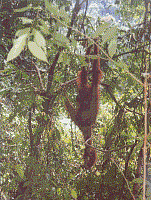
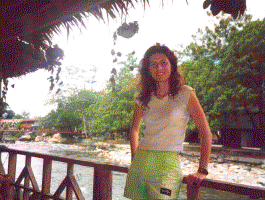
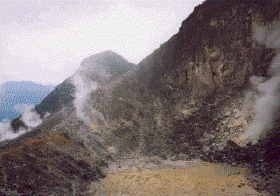
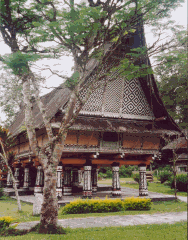
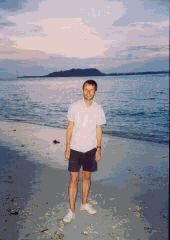
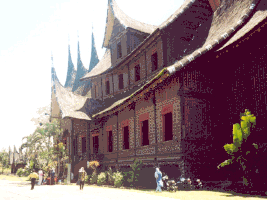
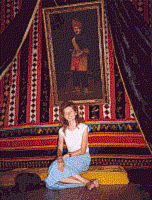 Palace*
Palace*